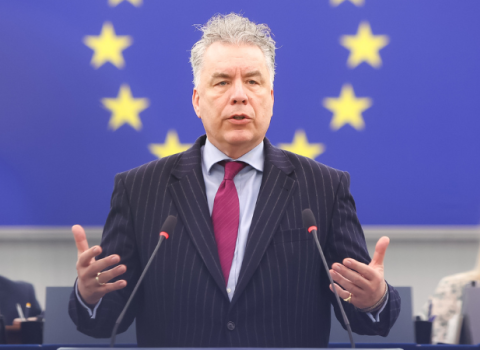There is still ‘a huge gap’ between outputs of research projects and uptake down on the farm. So how can farmers extract value from €10B the EU proposes to spend on agri-R&D in Horizon Europe?
Jerzy Plewa, director-general of the European Commission's agriculture directorate speaking at a Science|Business roundtable. Photo: Lysiane Pons, Science|Business
Brussels is proposing a €10 billion investment in agricultural research post-2020 - but will it yield real-world benefits across the continent’s 10 million farms?
The EU in June announced the spending, to be divided among food, agriculture and rural development projects, under the EU’s 2021-2027 research programme, Horizon Europe.
“It’s substantially bigger than what we’ve invested before,” Jerzy Plewa, director-general of the European Commission’s agriculture directorate, told a Science|Business roundtable on Wednesday.
There is the promise that research can make farming easier. The EU money offers new opportunities for farmers, who today find they have to take on the dual role of chief technology officers with their sensors, apps and communications equipment.
Researchers can use the funding to find alternatives to pesticides or protein sources, for example, or investigate ways that farms can benefit from artificial intelligence, Plewa said. Seeding, once done by hand, could be taken over by machines. Farmers could work more with satellite data, and perhaps grow to compete with giant agribusinesses.
New technologies promise to bring efficiencies to the millennia-old science of agriculture, but first farmers have to adopt them. Here, many see challenges.
“Definitely, we have to deliver innovation for farmers. But how will we manage to spend the €10 billion? We still have a huge gap between results of research and [uptake] by agriculture,” said Achim Irimescu, former minister of agriculture in Romania, now head of agriculture at the Permanent Representation of Romania to the EU.
Irimescu says that small farmers are already feeling the squeeze of the agri-investment giants who are among the big winners of the EU's common agricultural policy subsidies.
While these big farms stand to benefit from more research resources, others will lose. The huge spending on farming is in the line of fire in the EU’s next budget, facing a proposed 5 per cent cut post-2020. With subsidies for farmers expected to fall, the extra allocation to agriculture research is an apparent sop to the EU Agricultural Commissioner, Phil Hogan.
In the past decade, investing in agricultural research has dropped down the list of priorities for richer countries. EU spending in this area is rising, but remains a small fraction of total spend on research on the continent – at around 8 per cent. Horizon 2020 grants go to researchers investigating ways to automate farm tasks, increase resistance against pest and diseases, and conserve rare plants and animals. The EU will back 300 agriculture projects by the end of 2020.
Irimescu fears that, with fewer direct subsidies from Brussels, some of the continent’s smaller farms could fade away. “What about eastern Europe? We are reducing the gap but not overnight. Western countries are well ahead,” he said.
Furthermore, the cost of adopting the latest research or technology is beyond the smallest farmers.
“EU-funded projects are laudable and the results are there. The problem is the follow-up. When the cycle is done, there is no more money to keep it going,” said Robert de Graeff, policy and research officer with the European Landowners’ Association, which is involved in 20 EU-funded research projects.
“We should make sure to ask ourselves: what do we do after the end date of projects?”
There might be even less money, with a threat from the European Parliament to cut agricultural science. Christian Ehler, a lead rapporteur on Horizon Europe for the Parliament, has questioned the wisdom of setting aside €10 billion for research in this area.
“We are proposing to triple investment here,” Ehler said recently. “Obviously I doubt that this should be the priority for a research programme.” He declined to say how much should be invested in agriculture R&D. “It would be my sudden death,” he said. An amendment in his report on Horizon Europe leaves the budget for this unspecified.
Fields such quantum technology are a bigger priority, Ehler said. “Is Europe about agricultural subsidies, or would we like to see ourselves eye to eye with the ambitions of China?”
Risk of standing still
Farms in Europe that cannot afford the latest technology are at risk of standing still, attendees heard.
“Farmers typically inherit their business [rather than grow it up from the bottom] – they are not used to making innovations,” said Peter Pickel, deputy director of the European Technology Innovation Center at John Deere, a global machinery manufacturer. “They are not used to doing research. The idea of changing farmers into innovators is very good but the financial incentive is not enough. We need to offer free consultancy.”
Plewa acknowledged that older farmers are less likely to take up new research or technology.
“We have a problem. There are different farmers. Some are old and not necessarily so interested in new technologies. Younger farmers [below 40 years] adopt new approaches much more easily,” he said.
Still, he remains “a little bit more optimistic” than others. “I think if science and innovators deliver good products to farmers, they will be keen to use them.”





 A unique international forum for public research organisations and companies to connect their external engagement with strategic interests around their R&D system.
A unique international forum for public research organisations and companies to connect their external engagement with strategic interests around their R&D system.